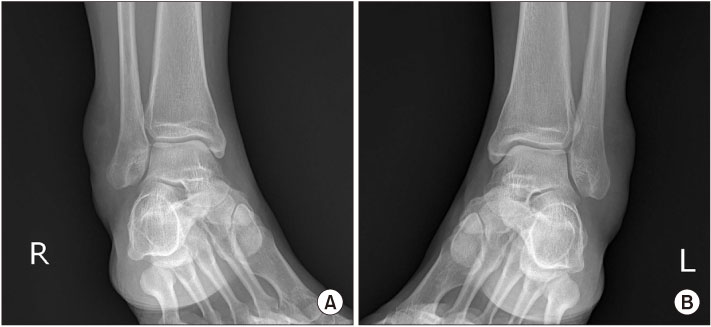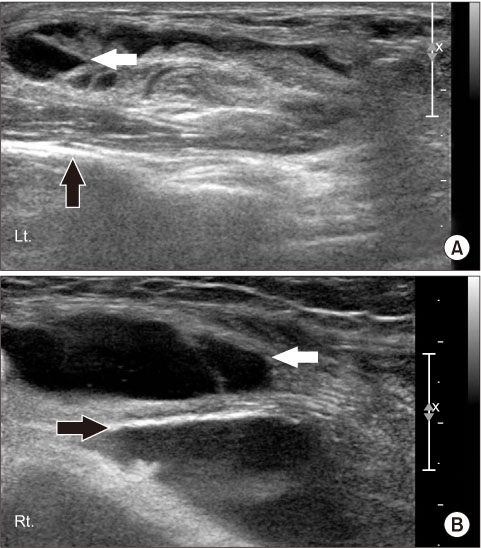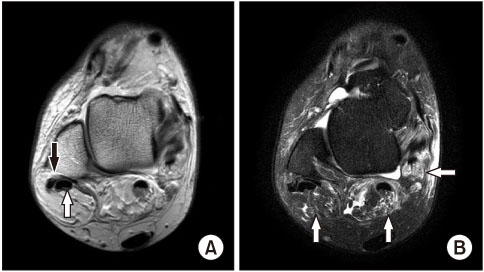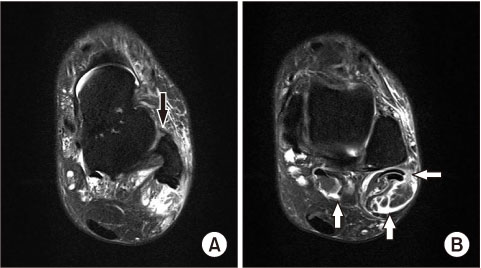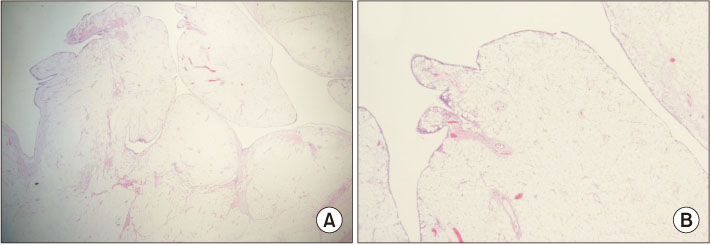J Korean Foot Ankle Soc.
2019 Mar;23(1):35-38. 10.14193/jkfas.2019.23.1.35.
Tenosynovial Bilateral Lipoma Arborescens of the Ankle in Adults
- Affiliations
-
- 1Department of Orthopedic Surgery, Inje University Busan Paik Hospital, Inje University College of Medicine, Busan, Korea. rmaqjawjr@gmail.com
- 2Department of Radiology, Inje University Busan Paik Hospital, Inje University College of Medicine, Busan, Korea.
- KMID: 2440583
- DOI: http://doi.org/10.14193/jkfas.2019.23.1.35
Abstract
- Lipoma arborescens or synovial lipomatosis is a rare disorder that is characterized by mature fat infiltration of the hypertrophic synovial villi, most frequently affecting the supra-patellar pouch of the knee. This paper presents a case of lipoma arborescens of the ankle joint bilaterally in an adult patient with involvement of both the intra-articular synovium and the synovial sheath of the tendons around the ankle.
MeSH Terms
Figure
Cited by 1 articles
-
Intramuscular Giant Lipoma of the Anterior Compartment of the Ankle: A Case Report
Min Gu Jang, Jae Hwang Song, Jin Woong Yi, Dae Yeung Kim
J Korean Foot Ankle Soc. 2020;24(3):124-127. doi: 10.14193/jkfas.2020.24.3.124.
Reference
-
1. Vilanova JC, Barceló J, Villalón M, Aldomà J, Delgado E, Zapater I. MR imaging of lipoma arborescens and the associated lesions. Skeletal Radiol. 2003; 32:504–509.
Article2. Kakkar N, Vasishta RK, Anand H. Pathological case of the month. Synovial lipomatosis. Arch Pediatr Adolesc Med. 1999; 153:203–204.3. Laorr A, Peterfy CG, Tirman PF, Rabassa AE. Lipoma arborescens of the shoulder: magnetic resonance imaging findings. Can Assoc Radiol J. 1995; 46:311–313.4. Arzimanoglu A. Bilateral arborescent lipoma of the knee: a case report. J Bone Joint Surg Am. 1957; 39-A:976–979.5. Hallel T, Lew S, Bansal M. Villous lipomatous proliferation of the synovial membrane (lipoma arborescens). J Bone Joint Surg Am. 1988; 70:264–270.
Article6. Soler T, Rodríguez E, Bargiela A, Da Riba M. Lipoma arborescens of the knee: MR characteristics in 13 joints. J Comput Assist Tomogr. 1998; 22:605–609.
Article7. Siva C, Brasington R, Totty W, Sotelo A, Atkinson J. Synovial lipomatosis (lipoma arborescens) affecting multiple joints in a patient with congenital short bowel syndrome. J Rheumatol. 2002; 29:1088–1092.8. Huang GS, Lee HS, Hsu YC, Kao HW, Lee HH, Chen CY. Tenosynovial lipoma arborescens of the ankle in a child. Skeletal Radiol. 2006; 35:244–247.
Article9. Hughes M, Burtt S, Ramabhadran B. Lipoma arborescens-a rare cause of bilateral ankle tenosynovitis. Rheumatology (Oxford). 2018; 57:762–763.
Article
- Full Text Links
- Actions
-
Cited
- CITED
-
- Close
- Share
- Similar articles
-
- Lipoma Arborescens in the Hip Joint: A Case Report
- Lipoma Arborescens of Hip Joint: A Case Report
- Lipoma Arborescens in the Knee Joint: A Case Report
- Arthroscopic Treatment of the Lipoma Arborescens in All Compartments of the Knee: A Case Report
- The Arthroscopic Treatment of Lipoma Arborescens of Knee: A Case Report


